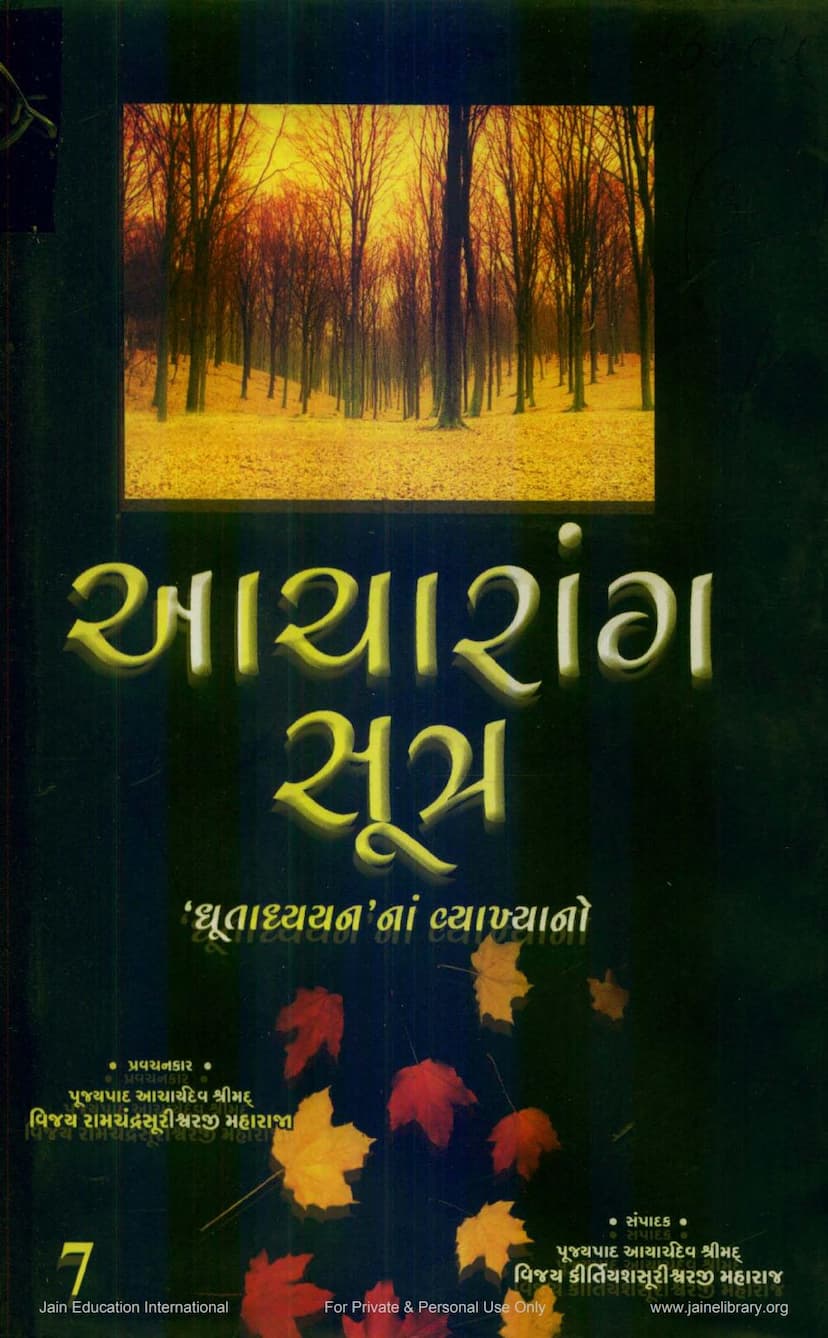Agam 01 Ang 01 Acharanga Sutra Part 07
Added to library: September 1, 2025

Summary
This is a summary of the key aspects of the "Agam 01 Ang 01 Acharanga Sutra Part 07," based on the provided Gujarati text:
Book Title: Agam 01 Ang 01 Acharanga Sutra Part 07 (આચારાંગ સૂત્ર – ધૂતાધ્યયનનાં વ્યાખ્યાનો – ભાગ-૭) Author: Ramchandrasuri (as the original commentator) and Acharya Shrimad Vijay Ramchandrasurishwarji Maharaj (as the preacher of the lectures). Publisher: Sanmarg Prakashan / JanmAshtami Prakashan Content: This volume contains 19 lectures (Pravachan 1 to 20) by Acharya Shrimad Vijay Ramchandrasurishwarji Maharaj, based on the Acharya Sutra's Dhutadhyayana. The lectures cover pages 117 to 135 of the original text and also refer to pages 1709 to 2003.
Core Themes and Discussions:
The lectures delve into profound aspects of Jain philosophy and practice, with a strong emphasis on correct perception (Samya Darshan) as the foundation of Jainism. Key themes include:
- The nature of suffering in the four realms of existence: The text elaborates on the inherent suffering in the hellish, animal, human, and divine realms, highlighting that true happiness lies only in liberation (Moksha).
- The meaning of Dharma: Dharma is explained as medicine for the "disease" of worldly existence (Samsara), with Moksha being the ultimate health.
- Correct Belief and Action: The paramount importance of right belief (Samya Darshan) as the root of right conduct (Samyak Charitra) is stressed. Wrong beliefs (Mithyatva) are identified as the source of all suffering and vice.
- The purpose of religious practices: The lectures clarify why Devotion to God, Guru, and Dharma is essential – it's for the soul's ultimate welfare, not for material gains.
- Distinction between ethics and religion: The text differentiates between mere ethical conduct (Niti) and true Dharma, emphasizing that ethical actions become truly religious when performed for self-purification and detachment from sin.
- The path to liberation: The lectures discuss the goal of religious practice and the nature of the path, the cycle of birth and death, the sorrows of the four life-forms, the violence caused by attachment to senses, the supremacy of Jinagam (Jain scriptures), and the compassion shown by Tirthankaras.
- The significance of wisdom and effort: The necessity of wisdom (Vivek) and personal effort (Purusharth) in spiritual progress is highlighted.
- The importance of service and the role of the monastic order (Gachha): The text discusses the true nature of service and the beneficial role of the monastic community.
- Addressing common misconceptions and criticisms: The lectures engage with various questions and criticisms regarding Jain practices, such as the possibility of violence against violent beings, the appropriateness of child initiation, the permissibility of teaching activities that involve sin, the authority of opinions, the testing of ascetics by householders, the proper way to study scriptures, and the connection between belief and practice.
- Critique of superficial religiosity: The lectures strongly condemn hypocrisy and mere outward show of religiosity without genuine inner transformation. It criticizes those who perform rituals without understanding their deeper meaning or purpose.
- The essence of "Dhunnan" (meditation/reflection): The text emphasizes that true "Dhunnan" requires sincere effort and a proper understanding of the scriptures, not just outward performance.
- The meaning of "Sangh": The lectures clarify the true meaning of "Sangh" (community) in Jainism, distinguishing it from mere crowds or opportunistic gatherings. It emphasizes that a true Sangh upholds the teachings of the Tirthankaras.
- The role of ascetics (Munis): The lectures highlight the ideal role of ascetics as exemplars of detachment and spiritual pursuit.
- The limitations of worldly knowledge: The text contrasts worldly wisdom with spiritual knowledge, emphasizing that true wisdom comes from adherence to scriptures and the guidance of enlightened souls.
Key Message:
The overarching message of this volume is the indispensable role of right perception (Samya Darshan) in the Jain way of life. Without this foundational understanding, even outwardly virtuous actions can be misguided. The lectures aim to instill a deep understanding of Jain principles, encouraging followers to live a life of detachment, compassion, and diligent practice, aligning their actions with their beliefs. The emphasis is on inner transformation and understanding the true essence of Jainism rather than superficial adherence.
Target Audience:
This text is intended for Jain followers seeking a deeper understanding of their faith, particularly concerning the philosophical underpinnings of their conduct and the path to spiritual liberation. It aims to guide individuals towards genuine spiritual practice and away from superficial religiosity.